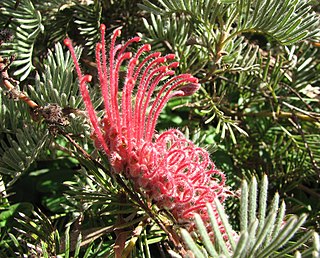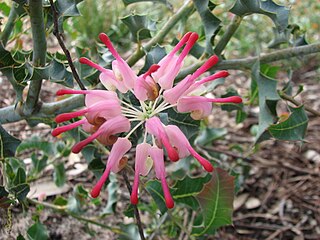
Leptospermum scoparium, commonly called mānuka, mānuka myrtle, New Zealand teatree, broom tea-tree, or just tea tree, is a species of flowering plant in the myrtle family Myrtaceae, native to New Zealand and south-east Australia. Its nectar produces Mānuka honey.

Banksia nana, commonly known as dwarf dryandra, is a species of shrub that is endemic to a small area in the south-west of Western Australia. It has underground stems, pinnatipartite leaves with sharply-pointed lobes, pale green or yellow flowers and broadly egg-shaped follicles.

Banksia nobilis, commonly known as the golden dryandra, great dryandra or kerosene bush, is a shrub of the family Proteaceae which is endemic to Western Australia. It occurs on lateritic rises from Eneabba to Katanning in the state's Southwest Botanic Province. With large pinnatifid leaves with triangular lobes, and a golden or reddish pink inflorescence, it is a popular garden plant. It was known as Dryandra nobilis until 2007, when all Dryandra species were transferred to Banksia by Austin Mast and Kevin Thiele. There are two subspecies, B. nobilis subsp. nobilis and B. nobilis subsp. fragrans.

Banksia proteoides, commonly known as king dryandra, is a shrub endemic to Western Australia. It was known as Dryandra proteoides until 2007, when all Dryandra species were transferred to Banksia by Austin Mast and Kevin Thiele.

Banksia serratuloides is a species of small shrub that is endemic to Western Australia. It has linear, pinnatipartite leaves, yellow and pink flowers in heads of about forty and hairy, wrinkled follicles.

Banksia splendida, commonly known as shaggy dryandra, is a species of shrub that is endemic to the southwest of Western Australia. It has sharply-pointed linear leaves that are woolly on the lower surface, cream-coloured and maroon or yellow flowers in heads of between 65 and 115, and later up to eight egg-shaped follicles in each head.

Grevillea thyrsoides is a species of flowering plant in the family Proteaceae, and is endemic to the southwest of Western Australia. It is a small, spreading or low-lying shrub, with pinnatisect to comb-like leaves, the end lobes linear, and clusters of hairy pinkish-red flowers.

Comesperma is a genus of shrubs, herbs and lianas in the family Polygalaceae. The genus is endemic to Australia. It was defined by the French botanist Jacques Labillardière in his 1806 work Novae Hollandiae Plantarum Specimen. The genus name is derived from the Ancient Greek words come ("hair") and sperma ("seed"), and relates to the seeds bearing tufts of hair. The genus is distributed over southern Australia, particularly in the southwest of Western Australia, where 19 species are found. 24 species have been described.
George Maxwell (1804–1880) was a professional collector of plants and insects in Southwest Australia. The botanical specimens he obtained were used to make formal descriptions of the region's plant species.

The flora of Western Australia comprises 10,551 published native vascular plant species and a further 1,131 unpublished species. They occur within 1,543 genera from 211 families; there are also 1,317 naturalised alien or invasive plant species more commonly known as weeds. There are an estimated 150,000 cryptogam species or nonvascular plants which include lichens, and fungi although only 1,786 species have been published, with 948 algae and 672 lichen the majority.

Boronia molloyae, commonly called the tall boronia, is a plant in the citrus family that is endemic to coastal regions in the south-west of Western Australia. It is a shrub with pinnate leaves that mostly have between three and seven leaflets, and deep rose pink, four-petalled flowers. It usually grows along streams in sandy soil.
Persoonia rufiflora is a species of flowering plant in the family Proteaceae and is endemic to the south-west of Western Australia. It is an erect, sometimes spreading shrub with hairy young branchlets, lance-shaped to linear leaves, and hairy, greenish yellow flowers arranged singly or in pairs.

Grevillea insignis, commonly known as wax grevillea, is a species of flowering plant in the family Proteaceae and is endemic to the south-west of Western Australia. It is an erect, bushy shrub with more or less oblong leaves with seven to seventeen sharply-pointed, triangular teeth, and more or less spherical or cylindrical clusters of cream-coloured flowers ageing to pink.

Gastrolobium leakeanum, commonly known as the mountain pea, is a plant in the pea family Fabaceae that is endemic to a small area in the south-west of Western Australia. It is an erect or sprawling shrub to about 2 m high, with red to orange or yellow flowers in spring.

Eremophila interstans is a flowering plant in the figwort family, Scrophulariaceae and is endemic to Australia. It is a shrub or small tree found in Western Australia and South Australia and has narrow leaves with a hooked end, and white or cream-coloured flowers.

Darwinia sanguinea is a species of flowering plant in the myrtle family Myrtaceae and is endemic to the south-west of Western Australia. It is a prostrate, sprawling shrub that typically grows to a height of 5–20 cm (2.0–7.9 in) and has reddish purple flowers between August and December.
Glischrocaryon flavescens is a perennial herb with woody roots that occurs in southern and western Australia.

Comesperma drummondii, commonly known as Drummond's milkwort, is a slender herb in the family Polygalaceae. It is a perennial herb growing to between 20 cm and 1.2 m high, on sandy and gravelly soils Its pink-blue-purple flowers may be seen from August to November.

Comesperma integerrimum is a twining shrub or climber in the family Polygalaceae.

Comesperma virgatum, commonly known as milkwort, is a herb in the family Polygalaceae. It is an erect slender herb growing to between 30 cm and 1.6 m high, on sandy and lateritic soils, and sometimes in swampy conditions. Its pink to purple flowers may be seen from September to December or January to March.




















